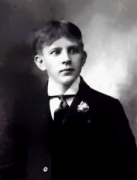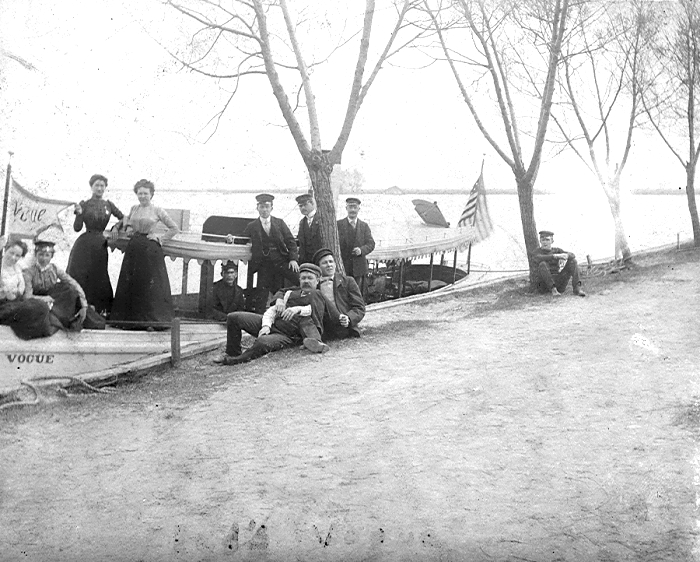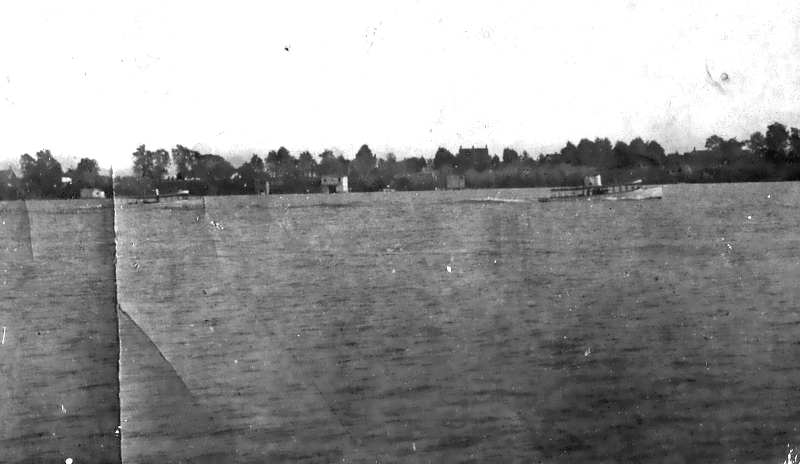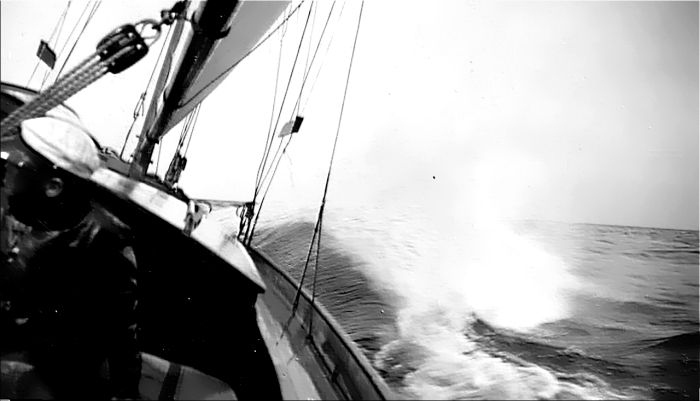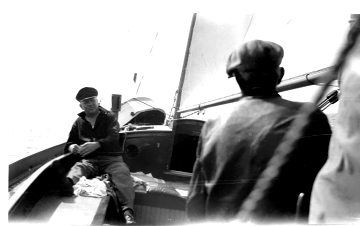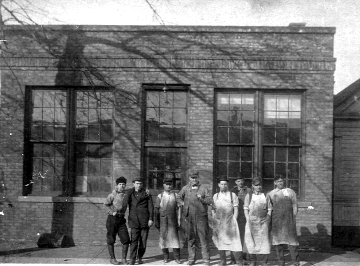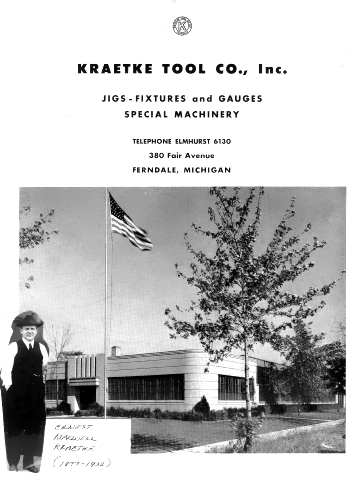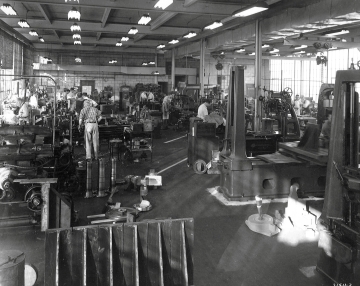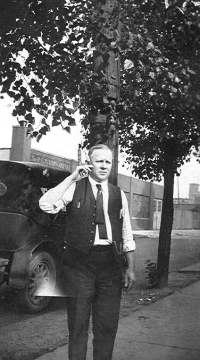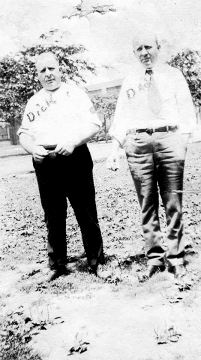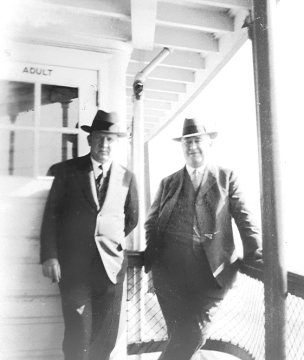Ernest attended Detroit public schools, the Seminary school of that city, and was also a student in night school for a period of time. After completing his education, he worked for the J. V. Campbell Brokerage Company and continued there after it became Cameron Currie & Company.
By the early 1900's, Detroit was developing into the center of the automobile industry, through the inventive spirit of individuals such as Henry Ford, brothers Horace and John Dodge, and Ransom E. Olds. The era of the automobile began about 1900 and by 1903, some of the early leading models were being built in Detroit, as well as in nearby Dearborn.
Henry Ford built a "Quadricyle" in 1896, but his invention did not sell. In 1902 he made the racing car "Old 99", which broke many speed records and drew the attention of several investors. In order to start an automobile manufacturing plant, Henry was in need of additional financing, so he approached Ernest for help. After some thought, Ernest agreed to assist Henry with a loan of $10,000. In 1903, with his newly acquired funds, Henry started the Ford Motor Company. He purchased a one story building on Mack Avenue in Detroit and employed ten eager workers for a salary of $1.50 per day.
During the time period 1903-1908, Henry Ford had numerous financial "ups and downs". His company was failing and in order to remain competitive with the many other automobile manufacturers, he wanted to expand his business and increase production. In need of money again, Henry approached Ernest for a second loan. This time Ernest denied the request, having based his decision on Henry Ford's past inability to keep his automobile company solvent.
Ernest married Margaret Marjorie Farrell in August of 1903. The 1910 Federal Census states they lived in a rental house on Hurlbut Avenue in Detroit, with their three children. Also living in the home was Ernest's unmarried sister-in-law, Sarah Farrell, who came to visit one day and stayed for another forty years. By 1930, Ernest and Margaret lived on Burns Avenue and their family had grown to seven children. At that time, the Kraetkes owned their house for which they paid $20,000.
For many years, Ernest, Margaret and their seven lively children, twin girls, Marjorie and Dorothy; Ernest; Sarah; Pauline; Richard; and Louis; spent their summer months at the same cottage in Kingsville, Ontario, Canada. The cottage sat on a cliff overlooking Lake Erie, in an area known as Wigles Grove. The family packed trunks and more trunks of clothing and other necessary items, to take to the cottage each season and all spent many happy days frolicking in "The Grove" and on the white sandy beaches of Lake Erie.
One of Ernest's granddaughters has a model of a German submarine displayed in a glass and wood case. The model, which belonged to Ernest, has a brass plate on the front of the case inscribed with the words, "Kriegsesang Lager Amherst 1917". In searching for what the inscription means, "Kriegsgesang" is the name of a popular W. W. I song and "Lager Amherst" translates as a German brewery.
Ernest's oldest grandson recalls the model sat in a case in his grandparents dining room and the vessel is a W. W. I. German submarine hand-crafted out of match sticks by a German Prisoner of War. During W. W. I., Ernest was asked by government officials to act as an interpreter. While performing his duty, Ernest and the German P. O. W. being held in Detroit, became close friends. When the submarine model was completed, the P.O.W. gave it to Ernest as an expression of his appreciation and friendship (see photograph).
Ernest and his two brothers, Richard Emil and William Louis Kraetke, founded a machinery and tool manufacturing company between 1903 and 1914, the date depending on where the information is obtained. The brothers named the business "Kraetke Bros. Inc." and the first plant was located on Jefferson Ave. in Detroit. The brothers evenly divided the work responsibilities, with Ernest managing the financial end, while Richard's job was sales, and William served as superintendent of the machine shop. The company's major accounts were Cadillac, Ford Motor, and Hudson Motor Car Companies. Prior to W. W. I., "Kraetke Bros. Inc." provided jigs, fixtures, and other special machinery to the motor companies, items necessary to the manufacturing of automobiles. The Kraetke brother's business contributed vital material to the war effort for both W. W. I. and W. W. II.
After the deaths of Richard in 1927 and Ernest in 1932, William Kraetke ran the business with the help of his nephew, Ernest Farrell Kraetke, Ernest's oldest son. William retired in 1939 and his nephew took over the business, forming a new company called "Kraetke Tool".
In 1936, Preston Thomas Tucker developed a power operated gun turret, which the United States Government purchased to attach on top of tanks and other military equipment. At that period of time, America had managed to remain isolated from the escalating problems in Europe arising from Hitler's Germany, however, preparations for a possible military involvement were underway.
Preston opened a very small manufacturing company on his farm located just outside of Ypsilanti, Michigan. He engaged Kraetke Tool to make various parts for the gun turret, but actual production of the military equipment was done in Tucker's shop. Preston was a well known and very clever promoter. In a grand public relations move, he notified the press of his government contract and provided them with photographs of his newly developed gun turret, affixed to the top of many army tanks. In actuality, Preston had placed one tank with a turret in the parking lot of Kraetke Tool, but when a photograph of the tank was printed by newspapers, the original had been doctored to look as if hundreds of tanks were lined up side by side.
After Ernest's son, Richard William Kraetke, was discharged from the Army in 1946, he went to work as a salesman for Kraetke Tool Company. That same year, Preston Thomas Tucker developed an automobile whose design was far ahead of the times. Again, Preston solicited Kraetke Tool to manufacture various parts for what became known as "The Tucker Automobile". Richard was sent to Preston's manufacturing plant in Chicago, Illinois, to pay a courtesy call. Prior to Richard's visit, Kraetke Tool had been lead to believe Preston was in the process of mass producing his car. When Richard arrived at the Tucker plant, there was only one automobile on the assembly line. Needless to say, Preston Thomas Tucker's dream failed, his business venture collapsed, and only about 50 of the cars were produced. Preston had creditors "knocking at his door", including Kraetke Tool Company to whom he owed more than $50,000. Kraetke Tool never received any payment from Preston and the financial loss was a contributing factor to the company "closing its doors" in 1948.
As a very young man, Ernest purchased a power boat he named the "Vogue". In the early 1900's he enjoyed racing his steam run boat on the Detroit River, using many family members and friends for his crew. Horace Dodge, of automobile fame, was an ambitious, risk-taking, hard-drinking gentleman. By 1916, he and his brother, John Dodge, both expert mechanics, had established Dodge Brothers Inc., with an automobile assembly line located in Hamtramack, Michigan.
Horace, the youngest Dodge brother, loved yachting. In 1904 he ordered a 40-foot launch built, which he named the "Hornet". Horace entered his boat, powered by steam, in the very first race of its kind to be held on the Detroit River. Ernest also entered his boat, the "Vogue", in the race. Ernest won, taking first place away from competitor, Horace Dodge. He was awarded a "Loving Cup" and today the prized cup is in the possession of one of Ernest's Grandsons.
Ernest was an avid sailor. He bought his first sailboat at age of twenty-one and named it the C'yonepe (German). In 1927, he had a sailboat built in Boston, Massachusetts by a firm called Casey Boat Works. He named the boat the "Margie K" in honor of his wife and when completed, Ernest sailed the 44 foot yawl home from Boston to Detroit. Ernest, his numerous family members, and many friends, spent happy times sailing the "Margie K." He entered races, including the one at the Straits of Mackinaw, which the magnificent yawl won with the help of a most able crew.
Sometime prior to his death in April of 1932, Ernest sold the "Margie K" to long time family friend, Richard P. Joy. That same year Richard sold the sailboat, renamed the "Rainbow IV", to experienced Detroit yachtsman, Percy Williamson. In July of 1942, the 44-foot yawl, "Rainbow IV", was reported destroyed in an explosion at Mackinac Island. Although the Detroit Free Press indicated the "Rainbow IV" suffered damages way beyond repair, that information turned out to be incorrect. The sailboat was fully restored and continued to compete in races in the United States and Mexico for another twenty or more years. Between 1960 and 1961, Richard Kraetke, Ernest's son, contacted the owner of his father's former yawl. Richard and his wife, Barbara, were residing in Newport Beach, California. They came across a newspaper article which said the "Rainbow IV" was soon to compete in the well known San Diego to Ensenada, Mexico Race. Richard managed to obtain the owner's telephone number and spoke with him at length. The two met and Richard was taken aboard his father's beloved boat, for a "walk down nostalgia lane". The Rainbow's owner invited Richard to sail with him to San Diego, unfortunately he was unable to accept due to other commitments. In the mid 1970's, three of Ernest's grandsons also located the "Margie K", but in Michigan. They contacted the yawl's owner and were invited aboard for a sail. It was a memorable and unforgettable experience, an adventure they will never forget.
Ernest Maxwell Kraetke was a member of the Benevolent Protective Order of Elks, the Detroit Yacht Club, and the Bay View Yacht Club. He enjoyed painting with oils in his spare time, mostly landscapes. Sadly, Ernest died of a self-inflicted gunshot wound to the chest. His body was found by his oldest son, Ernest Farrell Kraetke, in a restroom of the Kraetke Tool building on Grand Boulevard. The family's physician stated Ernest had a terminal brain tumor from advanced colon cancer, which had metastasized. In the many months prior to his death, Ernest suffered horrific headaches. Some claimed he was quite despondent. The exact reason for his suicide will remain a mystery, however one fact is known, Ernest was loved by his wife and children and his presence was always missed.
If you ever visit "Wigles Grove", be sure to look off into the distance, as you may very well see the yawl "Margie K" gliding across the glistening blue waters of Lake Erie, manned by a full crew……
Ernest attended Detroit public schools, the Seminary school of that city, and was also a student in night school for a period of time. After completing his education, he worked for the J. V. Campbell Brokerage Company and continued there after it became Cameron Currie & Company.
By the early 1900's, Detroit was developing into the center of the automobile industry, through the inventive spirit of individuals such as Henry Ford, brothers Horace and John Dodge, and Ransom E. Olds. The era of the automobile began about 1900 and by 1903, some of the early leading models were being built in Detroit, as well as in nearby Dearborn.
Henry Ford built a "Quadricyle" in 1896, but his invention did not sell. In 1902 he made the racing car "Old 99", which broke many speed records and drew the attention of several investors. In order to start an automobile manufacturing plant, Henry was in need of additional financing, so he approached Ernest for help. After some thought, Ernest agreed to assist Henry with a loan of $10,000. In 1903, with his newly acquired funds, Henry started the Ford Motor Company. He purchased a one story building on Mack Avenue in Detroit and employed ten eager workers for a salary of $1.50 per day.
During the time period 1903-1908, Henry Ford had numerous financial "ups and downs". His company was failing and in order to remain competitive with the many other automobile manufacturers, he wanted to expand his business and increase production. In need of money again, Henry approached Ernest for a second loan. This time Ernest denied the request, having based his decision on Henry Ford's past inability to keep his automobile company solvent.
Ernest married Margaret Marjorie Farrell in August of 1903. The 1910 Federal Census states they lived in a rental house on Hurlbut Avenue in Detroit, with their three children. Also living in the home was Ernest's unmarried sister-in-law, Sarah Farrell, who came to visit one day and stayed for another forty years. By 1930, Ernest and Margaret lived on Burns Avenue and their family had grown to seven children. At that time, the Kraetkes owned their house for which they paid $20,000.
For many years, Ernest, Margaret and their seven lively children, twin girls, Marjorie and Dorothy; Ernest; Sarah; Pauline; Richard; and Louis; spent their summer months at the same cottage in Kingsville, Ontario, Canada. The cottage sat on a cliff overlooking Lake Erie, in an area known as Wigles Grove. The family packed trunks and more trunks of clothing and other necessary items, to take to the cottage each season and all spent many happy days frolicking in "The Grove" and on the white sandy beaches of Lake Erie.
One of Ernest's granddaughters has a model of a German submarine displayed in a glass and wood case. The model, which belonged to Ernest, has a brass plate on the front of the case inscribed with the words, "Kriegsesang Lager Amherst 1917". In searching for what the inscription means, "Kriegsgesang" is the name of a popular W. W. I song and "Lager Amherst" translates as a German brewery.
Ernest's oldest grandson recalls the model sat in a case in his grandparents dining room and the vessel is a W. W. I. German submarine hand-crafted out of match sticks by a German Prisoner of War. During W. W. I., Ernest was asked by government officials to act as an interpreter. While performing his duty, Ernest and the German P. O. W. being held in Detroit, became close friends. When the submarine model was completed, the P.O.W. gave it to Ernest as an expression of his appreciation and friendship (see photograph).
Ernest and his two brothers, Richard Emil and William Louis Kraetke, founded a machinery and tool manufacturing company between 1903 and 1914, the date depending on where the information is obtained. The brothers named the business "Kraetke Bros. Inc." and the first plant was located on Jefferson Ave. in Detroit. The brothers evenly divided the work responsibilities, with Ernest managing the financial end, while Richard's job was sales, and William served as superintendent of the machine shop. The company's major accounts were Cadillac, Ford Motor, and Hudson Motor Car Companies. Prior to W. W. I., "Kraetke Bros. Inc." provided jigs, fixtures, and other special machinery to the motor companies, items necessary to the manufacturing of automobiles. The Kraetke brother's business contributed vital material to the war effort for both W. W. I. and W. W. II.
After the deaths of Richard in 1927 and Ernest in 1932, William Kraetke ran the business with the help of his nephew, Ernest Farrell Kraetke, Ernest's oldest son. William retired in 1939 and his nephew took over the business, forming a new company called "Kraetke Tool".
In 1936, Preston Thomas Tucker developed a power operated gun turret, which the United States Government purchased to attach on top of tanks and other military equipment. At that period of time, America had managed to remain isolated from the escalating problems in Europe arising from Hitler's Germany, however, preparations for a possible military involvement were underway.
Preston opened a very small manufacturing company on his farm located just outside of Ypsilanti, Michigan. He engaged Kraetke Tool to make various parts for the gun turret, but actual production of the military equipment was done in Tucker's shop. Preston was a well known and very clever promoter. In a grand public relations move, he notified the press of his government contract and provided them with photographs of his newly developed gun turret, affixed to the top of many army tanks. In actuality, Preston had placed one tank with a turret in the parking lot of Kraetke Tool, but when a photograph of the tank was printed by newspapers, the original had been doctored to look as if hundreds of tanks were lined up side by side.
After Ernest's son, Richard William Kraetke, was discharged from the Army in 1946, he went to work as a salesman for Kraetke Tool Company. That same year, Preston Thomas Tucker developed an automobile whose design was far ahead of the times. Again, Preston solicited Kraetke Tool to manufacture various parts for what became known as "The Tucker Automobile". Richard was sent to Preston's manufacturing plant in Chicago, Illinois, to pay a courtesy call. Prior to Richard's visit, Kraetke Tool had been lead to believe Preston was in the process of mass producing his car. When Richard arrived at the Tucker plant, there was only one automobile on the assembly line. Needless to say, Preston Thomas Tucker's dream failed, his business venture collapsed, and only about 50 of the cars were produced. Preston had creditors "knocking at his door", including Kraetke Tool Company to whom he owed more than $50,000. Kraetke Tool never received any payment from Preston and the financial loss was a contributing factor to the company "closing its doors" in 1948.
As a very young man, Ernest purchased a power boat he named the "Vogue". In the early 1900's he enjoyed racing his steam run boat on the Detroit River, using many family members and friends for his crew. Horace Dodge, of automobile fame, was an ambitious, risk-taking, hard-drinking gentleman. By 1916, he and his brother, John Dodge, both expert mechanics, had established Dodge Brothers Inc., with an automobile assembly line located in Hamtramack, Michigan.
Horace, the youngest Dodge brother, loved yachting. In 1904 he ordered a 40-foot launch built, which he named the "Hornet". Horace entered his boat, powered by steam, in the very first race of its kind to be held on the Detroit River. Ernest also entered his boat, the "Vogue", in the race. Ernest won, taking first place away from competitor, Horace Dodge. He was awarded a "Loving Cup" and today the prized cup is in the possession of one of Ernest's Grandsons.
Ernest was an avid sailor. He bought his first sailboat at age of twenty-one and named it the C'yonepe (German). In 1927, he had a sailboat built in Boston, Massachusetts by a firm called Casey Boat Works. He named the boat the "Margie K" in honor of his wife and when completed, Ernest sailed the 44 foot yawl home from Boston to Detroit. Ernest, his numerous family members, and many friends, spent happy times sailing the "Margie K." He entered races, including the one at the Straits of Mackinaw, which the magnificent yawl won with the help of a most able crew.
Sometime prior to his death in April of 1932, Ernest sold the "Margie K" to long time family friend, Richard P. Joy. That same year Richard sold the sailboat, renamed the "Rainbow IV", to experienced Detroit yachtsman, Percy Williamson. In July of 1942, the 44-foot yawl, "Rainbow IV", was reported destroyed in an explosion at Mackinac Island. Although the Detroit Free Press indicated the "Rainbow IV" suffered damages way beyond repair, that information turned out to be incorrect. The sailboat was fully restored and continued to compete in races in the United States and Mexico for another twenty or more years. Between 1960 and 1961, Richard Kraetke, Ernest's son, contacted the owner of his father's former yawl. Richard and his wife, Barbara, were residing in Newport Beach, California. They came across a newspaper article which said the "Rainbow IV" was soon to compete in the well known San Diego to Ensenada, Mexico Race. Richard managed to obtain the owner's telephone number and spoke with him at length. The two met and Richard was taken aboard his father's beloved boat, for a "walk down nostalgia lane". The Rainbow's owner invited Richard to sail with him to San Diego, unfortunately he was unable to accept due to other commitments. In the mid 1970's, three of Ernest's grandsons also located the "Margie K", but in Michigan. They contacted the yawl's owner and were invited aboard for a sail. It was a memorable and unforgettable experience, an adventure they will never forget.
Ernest Maxwell Kraetke was a member of the Benevolent Protective Order of Elks, the Detroit Yacht Club, and the Bay View Yacht Club. He enjoyed painting with oils in his spare time, mostly landscapes. Sadly, Ernest died of a self-inflicted gunshot wound to the chest. His body was found by his oldest son, Ernest Farrell Kraetke, in a restroom of the Kraetke Tool building on Grand Boulevard. The family's physician stated Ernest had a terminal brain tumor from advanced colon cancer, which had metastasized. In the many months prior to his death, Ernest suffered horrific headaches. Some claimed he was quite despondent. The exact reason for his suicide will remain a mystery, however one fact is known, Ernest was loved by his wife and children and his presence was always missed.
If you ever visit "Wigles Grove", be sure to look off into the distance, as you may very well see the yawl "Margie K" gliding across the glistening blue waters of Lake Erie, manned by a full crew……















